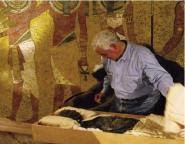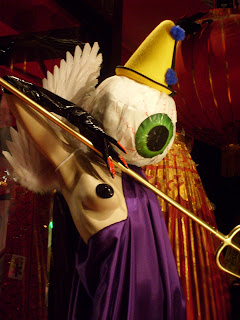
ALU is an Italian company that specializes in the design and manufacture of merchandising materials (racks, displays, fixtures, lighting arrangements), and other "systems" used to sell merchandise in a store. Before visiting the showroom, I mistakenly believed that ALU manufactured display mannequins, but upon arriving and being very warmly received by Robert Mabry, the President of ALU, I was not at all disappointed by the absence of painted heads.
The showroom at ALU is located on the 6th floor of an unassuming building in Chelsea. Exiting the rickety, slow, dumb-waiter like elevator, I immediately entered a futuristic, spacious, and extremely entrancing area. (The euphoria of the experience was something akin to Charlie and Grandpa Joe discovering the room in Willy's factory with the Fizzy Lifting drinks).
Twice a year, a creative team, headed by Luca from Italy, tears down the entire showroom and replaces it with an entirely new installation. The most recent theme is "Leave your Mark" a maze of red, white and black modish installations with a bit of a fun-house theme, balanced by a tasteful and streamline design.
Mabry introduced me to the "fixture industry" -- the world of racks, boxes, display cases, shelves, and drawers, that merchandisers hang, drape, set, and prop their products on--" We use our merchandise to showcase theirs," said Mabry. ALU prides itself on producing quality, aesthetically pleasing, and practical products that can be modulated to change the look or purpose of the fixture.
Mabry introduced me to the world of visual merchandising trade shows:
Euroshop, held annually in Dusseldorf, Germany, one of the largest.
Globalshop, held every March in Chicago -also gets a big part of the industry to spin out their latest wares.
NADI, the National Association of Display Industries http://www.nadi-global.com/# is also a tremendous source of information and networking in the industry, especially via the conferences, conventions, and events that it holds throughout the year.
NADI's mission is to report the evolution of the visual merchandising industry, which seems to require a rather savvy pulse taker. Just 6 years ago, the visual merchandising industry found 80% of its clients in major department stores. This figure has now dropped to 35%. Mabry explained that this shift in figures is due to consolidation within stores -- they've begun to use in-house people to take care of all of their merchandising needs, and thus rely less on the expertise and products of outside companies. Interestingly enough, despite these changes, the industry has kept growing. Instead of department stores, companies like ALU have begun doing store installations for car dealerships (BMW) and technological providers such as cell phone companies (Virgin Mobile). They design booths and cases in which to display things, and as a result have skillfully adapted to emerging markets and expanded their business scope.
ALU still provides many Mom and Pop shops as well as larger retailers such as Sears, JC Penney, Saks, and Bloomingdales with in-store fixtures, however as the market for visual material evolves, so do the needs and the nature of their customers.

















